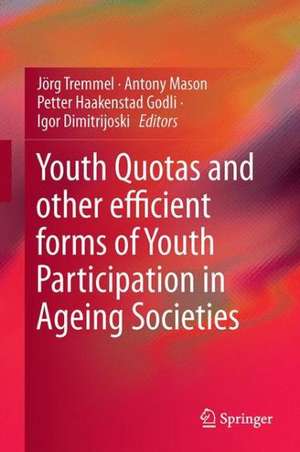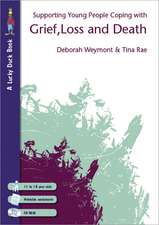Youth Quotas and other Efficient Forms of Youth Participation in Ageing Societies
Editat de Jörg Tremmel, Antony Mason, Petter Haakenstad Godli, Igor Dimitrijoskien Limba Engleză Hardback – 10 apr 2015
The book explores key questions regarding the implementation of youth quotas from different perspectives, including philosophy, political science, sociology and demography. It examines whether youth quotas and other measures that give the young more voice and influence in political institutions are a good means for promoting the cause of intergenerational justice. In particular, it investigates how and if youth quotas can be used to ensure that the environmental interests of young and future generations are being taken into account.
In addition, the book introduces an innovative model that would give a right to vote to minors without voting age boundaries. The book also discusses suffrage reforms through lowering the voting age in Western countries, as well as introducing methods especially aimed at raising the skills of children necessary for societal citizenship and empowerment of young citizens.
The volume will help raise awareness and knowledge about the intergenerational implications of demographic changes in Western democracies, where ageing societies are increasingly turning into gerontocracies. It offers readers deep insight into how youth quotas in particular (and others forms of youth participation in general) might be efficient methods to ensure that younger generations are included in the political decision making process and other activities in society.
| Toate formatele și edițiile | Preț | Express |
|---|---|---|
| Paperback (1) | 382.57 lei 6-8 săpt. | |
| Springer International Publishing – 9 oct 2016 | 382.57 lei 6-8 săpt. | |
| Hardback (1) | 389.88 lei 6-8 săpt. | |
| Springer International Publishing – 10 apr 2015 | 389.88 lei 6-8 săpt. |
Preț: 389.88 lei
Nou
Puncte Express: 585
Preț estimativ în valută:
74.60€ • 77.89$ • 61.74£
74.60€ • 77.89$ • 61.74£
Carte tipărită la comandă
Livrare economică 04-18 aprilie
Preluare comenzi: 021 569.72.76
Specificații
ISBN-13: 9783319134307
ISBN-10: 3319134302
Pagini: 188
Ilustrații: X, 188 p.
Dimensiuni: 155 x 235 x 17 mm
Greutate: 0.46 kg
Ediția:2015
Editura: Springer International Publishing
Colecția Springer
Locul publicării:Cham, Switzerland
ISBN-10: 3319134302
Pagini: 188
Ilustrații: X, 188 p.
Dimensiuni: 155 x 235 x 17 mm
Greutate: 0.46 kg
Ediția:2015
Editura: Springer International Publishing
Colecția Springer
Locul publicării:Cham, Switzerland
Public țintă
ResearchCuprins
Introduction: Youth Quotas - Mapping the Field: Jörg Tremmel, Antony Mason, Petter Haakenstad Godli, Igor Dimitrijoski.- What do Quotas do? Reflections on the Ubiquity and Justice of Quotas: Radostin Kaloianov.- Are Youth Quotas a Form of Ageism?: Tobias Hainz.- Better Procedure for Fairer Outcomes: Can Youth Quotas Increase our Chances of Meeting the Demands of Intergenerational Justice?: Juliana Bidadanure.- Can Youth Quotas Help Avoid Future Disasters? : Ivo Wallimann-Helmer.- Saving the Palnet by Empowering the Young? Anja Karnein and Dominic Roser.- Towards all Voices, From all Levels and in their Own Ways? A Discussion of the Youth Quotas Proposal as an Incremental Policy Innovation for Sustainability: Rafael Ziegler.- Encouraging and Supporting Children's Voices: Sarah-Jane Conrad, Claire Cassidy and Christian Mathis.- Democracy or Epistocracy? Aga as a Criterion of Who May Vote and Who May Not Vote: Jörg Tremmel and James Wilhelm.- Giving 16-year-olds the Vote. Experiences from Norway: Petter Haakenstad Godli.- Afterword: Libertarian Hesitations: Marcel Wissenburg.- List of Contributors.- Subject Index.
Recenzii
“The anthology Youth Quotas and other Efficient Forms of Youth Participation in Ageing Societies deals … with the challenge of demographic change in Western countries and its implications for the youth. … The anthology at hand lays the groundwork for further discussions and enables the reader to get to know the subject, as well as to engage with different ideas about youth participation in general.” (Lena Sommerfeld, Intergenerational Justice Review, Issue 2, 2015)
Textul de pe ultima copertă
This book examines ways to ensure that the rights, interests and concerns of young people are properly represented in Western democracies. One new proposal is the introduction of youth quotas in political institutions in order to counter the possible marginalization of young people caused by demographic ageing and, thereby, an overrepresentation of the interests of the elderly.
The book explores key questions regarding the implementation of youth quotas from different perspectives, including philosophy, political science, sociology and demography. It examines whether youth quotas and other measures that give the young more voice and influence in political institutions are a good means for promoting the cause of intergenerational justice. In particular, it investigates how and if youth quotas can be used to ensure that the environmental interests of young and future generations are being taken into account.
In addition, the book introduces an innovative model that wouldgive a right to vote to minors without voting age boundaries. The book also discusses suffrage reforms through lowering the voting age in Western countries, as well as introducing methods especially aimed at raising the skills of children necessary for societal citizenship and empowerment of young citizens.
The volume will help raise awareness and knowledge about the intergenerational implications of demographic changes in Western democracies, where ageing societies are increasingly turning into gerontocracies. It offers readers deep insight into how youth quotas in particular (and others forms of youth participation in general) might be efficient methods to ensure that younger generations are included in the political decision making process and other activities in society.
The book explores key questions regarding the implementation of youth quotas from different perspectives, including philosophy, political science, sociology and demography. It examines whether youth quotas and other measures that give the young more voice and influence in political institutions are a good means for promoting the cause of intergenerational justice. In particular, it investigates how and if youth quotas can be used to ensure that the environmental interests of young and future generations are being taken into account.
In addition, the book introduces an innovative model that wouldgive a right to vote to minors without voting age boundaries. The book also discusses suffrage reforms through lowering the voting age in Western countries, as well as introducing methods especially aimed at raising the skills of children necessary for societal citizenship and empowerment of young citizens.
The volume will help raise awareness and knowledge about the intergenerational implications of demographic changes in Western democracies, where ageing societies are increasingly turning into gerontocracies. It offers readers deep insight into how youth quotas in particular (and others forms of youth participation in general) might be efficient methods to ensure that younger generations are included in the political decision making process and other activities in society.
Caracteristici
Increases awareness and knowledge about the intergenerational implications of demographic changes in Western democracies Explores key questions regarding the implementation of youth quotas in political systems from different perspectives, including philosophy, political science, sociology and demography Investigates how and if youth quotas can be used to ensure that the environmental interests of young and future generations are being taken into account Includes supplementary material: sn.pub/extras











